Part 1.
Through the course of EDCI339, I have learned about two teaching styles and learning models and have gained an understanding of them. Open Learning and Distributed Learning are different teaching styles from the traditional teaching style, which is face-to-face in the classroom, where students listen to the teacher’s output of knowledge and input knowledge. Open learning and distributed learning are both ways to increase students’ interest and inclusion in learning. Distributed instruction allows students and professors to teach in a non-centralized manner and can be combined with traditional teaching models, such as the now popular zoom online classes. Open learning is where the teacher respects the students’ individual preferences and leaves as much of the learning initiative to the students as possible, with the teacher than making generalizations and summaries. The teacher plays a leading and mobilizing role, stimulates students’ curiosity, organizes and conducts discussions, and allows students to participate fully and actively. For example, in group work or social experiments, students are free to disseminate their ideas and what they have learned.
The direct purpose and meaning of open teaching were directly outlined in the first chapter of A GUIDE TO MAKING OPEN TEXTBOOKS WITH STUDENTS in the post-three reading article.“Open Pedagogy,” as we engage with it, is a site of praxis, a place where theories about learning, teaching, technology, and social justice enter into a conversation with each other and inform the development of educational practices and structures” (Mays, 2017).
 (note made from post three reading)
(note made from post three reading)
After reading the article about open learning, I felt happy that teachers are trying to make education democratized and student-centered. However, there may be students in poverty who do not have easy access to computers and the Internet, so I think this needs more social support and government support.
During the month of study, although the whole time was through the internet but I didn’t feel very far away from my classmates. I was able to receive feedback from the students quickly and I was able to read their blogs and give them some of my thoughts. I not only received positive thoughts from my classmates about my post, but also received more thoughts from the teachers about my ideas.
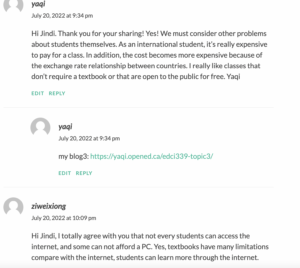
 (screenshots of others comments)
(screenshots of others comments)
In addition, I read and responded to the other group members’ ideas.
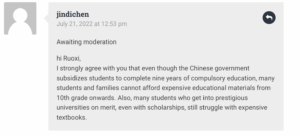
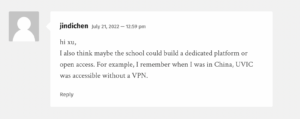 (screenshots of my comments to others)
(screenshots of my comments to others)
Perhaps when I first read the article, I would have misunderstandings or uncertain understandings, but by looking at the group’s posts I would feel confirmed and have a deeper understanding. I think these steps are open learning by discussing with the group and thanking each other for their comments.
Part 2.
The second post I remember that the article focused on the distributed teaching model, which is non-face-to-face teaching like this class. Even after I read the article I still felt fear and insecurity about online classes because of my own reasons. However, it also occurred to me that not all lessons and knowledge can be learned in school, such as the music arrangement I am writing about. Due to my field of study and school, I can only learn by enrolling in online distributed courses, and I also think that these courses are more suitable for this mode of learning. It allows me to follow my progress and get feedback anytime, anywhere.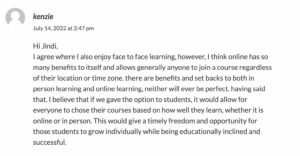
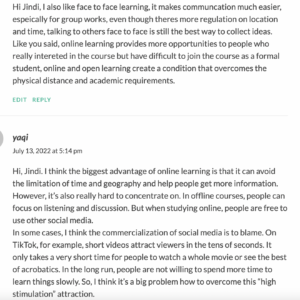
I agree with yaqi’s reply to me and the arguments I was trying to make. Offline traditional teaching is not student-centered enough, but it is immersive, and students cannot be distracted or do anything else. Whereas in an online course students are easily attracted to other interesting things on the internet.
In addition, it is clear from kenzie’s response that she prefers distributed instruction because it gives students the right to choose and is more liberal and inclusive.
Overall, both open learning and distributed learning are two ways of education and learning that are student-centered and aim for a better quality education. Students also have the right to choose and to improve the standard of education and learning through the use of both approaches.